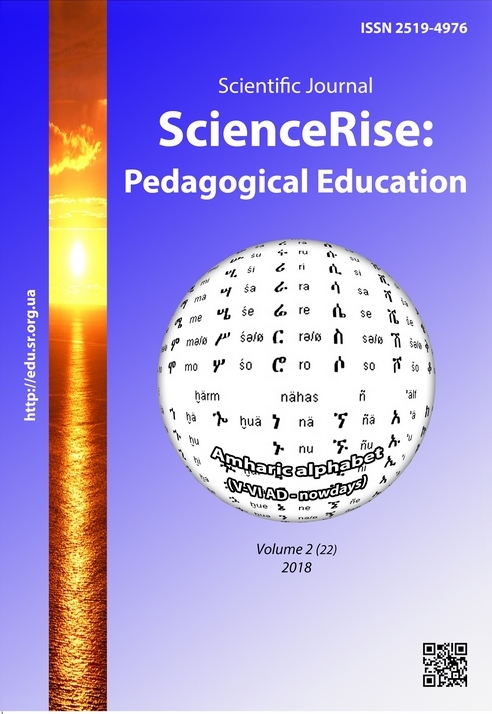Teachers’ multicultural education in Italy
DOI:
https://doi.org/10.15587/2519-4984.2018.124570Keywords:
multicultural education, educational pluralism, global society, intercultural education, cultural valuesAbstract
The article deals with an analysis of the process of teachers’ multicultural education in Italy. Multiculturalism has become an essential dimension of education in West European countries due to globalization which contributes to appearance of immigrants and necessitates organization of education with respect to cultural, ethnical, religious diversity. Italy, being a recipient country, is in the focus of attention of scientists who study education of ethnically diverse classes. The aim of the article was to provide analysis of education programs of Italian universities and find elements of programs and courses which facilitate learning about ethnical and cultural diversity in the world and develop skills of intercultural communication, professional activities and personal development under conditions of globalization. Programs of professional training in Milan and Padua universities were analyzed. We found that they include modules of cross-cultural communication, cultural diversity in the world, etc. The perspectives of further research involve study, interpretation, implementation of multicultural educational experience of West European countries in the system of professional training in Ukraine
References
- Intercultural cities: building a future on diversity. Available at: https://rm.coe.int/16804902dc
- Shadow reports on racism in Europe (2010). European network against racism. Available at: http://www.enar-eu.org/Shadow-Reports-on-racism-in-Europe-203
- White paper on intercultural dialogue “Living together as equals in dignity” (2008). Strasbourge, 61. Available at: https://www.coe.int/t/dg4/intercultural/source/white%20paper_final_revised_en.pdf
- Armillei, R.; Mansouri, F. (Ed.) (2015). A Multicultural Italy? Cultural, Religious and Political Contestations. Cham: Springer, 135–151. doi: 10.1007/978-3-319-16003-0_9
- Informativa sul trattamento di dati personali da parte dell’istituto nazionale di statistic (2011). Available at: http://www.istat.it/it/files/2011/02/Informativa-Lac_on-line.pdf
- Rocchia, A., Scassiano, L. (2008). Immigration in Italy, an overview: a long history of emigration and immigration. Our Europe, 3. Available at: http://est.indire.it/upload/07-ITA01-CO06-01359-2-prod-004.pdf
- Centre on Housing Rights and Evictions (2016). Available at: https://www.ngo-monitor.org/ngos/centre_on_housing_rights_and_evictions_cohre_
- Postryhach, N. O. (2015). Rozvytok neperervnoyi pedahohichnoyi osvity Italiyi u XXI stolotti [Continuous teacher education in italy in XXI century]. International Scientific Journal. Pedagogical sciences, 7, 31–35.
- Nelin, Ye. (2014). Osoblyvosti formuvania vyshchoi pedahohichnoi osvity v Italii v pershiy polovyni XX stolittia [Features of the formation of higher pedagogical education in Italy in the first half of the twentieth century]. Comparative-pedagogical studies, 4 (22), 77–84.
- Leeman, Y. (2006). Teaching in ethnically diverse schools: teachers' professionalism. European Journal of Teacher Education, 29 (3), 341–356. doi: 10.1080/02619760600795171
- Circolare No. 301/203. (1989). Available at: www.eduscuola.it/archivio/nofrme/cicolari/cm301_89html
- Milan University. Available at: http://www.unimi.it/ENG/courses/31178.htm
- Padua University. Available at: http://www.fisppa.unipd.it/corsi/corsi-laurea
Downloads
Published
How to Cite
Issue
Section
License
Copyright (c) 2018 Inna Kovalynska

This work is licensed under a Creative Commons Attribution 4.0 International License.
Our journal abides by the Creative Commons CC BY copyright rights and permissions for open access journals.
Authors, who are published in this journal, agree to the following conditions:
1. The authors reserve the right to authorship of the work and pass the first publication right of this work to the journal under the terms of a Creative Commons CC BY, which allows others to freely distribute the published research with the obligatory reference to the authors of the original work and the first publication of the work in this journal.
2. The authors have the right to conclude separate supplement agreements that relate to non-exclusive work distribution in the form in which it has been published by the journal (for example, to upload the work to the online storage of the journal or publish it as part of a monograph), provided that the reference to the first publication of the work in this journal is included.








